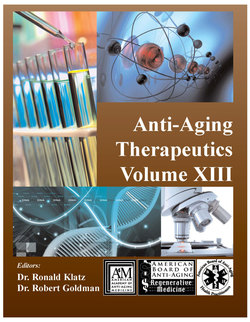Читать книгу Anti-Aging Therapeutics Volume XIII - A4M American Academy - Страница 30
На сайте Литреса книга снята с продажи.
The Ideal Phytosterol Composition
ОглавлениеBased upon the available literature and our clinical observations, the ideal balance of phytosterols is comprised of B-Sit being greater than 62%; campesterol being less than 25%; stigmasterol being less than 10%; and brassicasterol being less than 3%. The following is a brief summary of the evidence for this composition. (Note: most phytosterol supplements contain a maximum of 43% B-Sit. This is due to it being derived from currently available soy. The problem with using this material as a supplement is that is merely provides the same balance found in the food supplies that are associated with higher rates of cancer, cardiovascular disease, obesity, and type II diabetes. Both population studies and clinical observation show that the balance of the sterols, from supplement and diet, is more important than the absolute amount. Therefore, higher supplemental amounts of properly balanced phytosterols are needed to offset the low B-Sit content and ratio from the food supply.)
•Βeta-sitosterol (B-Sit), at least 62%, absorption rate approximately 4%:
1.Reduces absorption of dietary cholesterol.
2.High plasma concentrations are associated with a markedly reduced risk of coronary heart disease (n 1242, >65 y/o).13
3.Increases apoptosis in cancer cells (4 to 6-times baseline).14
4.High levels in diet correlate with lower levels of cancer (prostate, lung, breast, colorectal, etc.)
5.Anti-inflammatory14
6.Current healthy Mediterranean food supplies provide phytosterols with over 65% B-Sit/sitostanol content, while geographical areas with high cancer and disease rate have about 43% or less B-Sit (with about the same amounts of total phytosterols, about 400 mg/day) content in their food.15 U.S. intake is estimated at 50-250 mg/day, with 43% or less b-Sit.16
7.Immune System modulator
8.B-Sit, and campesterol, also reduced alpha-tocopherol oxidation in liposomal membranes.
9.Decreases plaque formation in arteries.
10.Reduces estradiol production and carries excess estradiol from the gut.
•Campesterol (CS), not exceeding 20%, absorption rate approximately 13%:
1.Increases apoptosis in cancer cells (estimated to be about 4 to 6 times baseline).
2.Increases plaque formation in arteries. Note: Statin drugs increase CS concentration in muscle tissue, reducing B-Sit content, and disrupting membrane balance.17
•Stigmasterol, not exceeding 10%, absorption rate approximately 4%:
1.Stigmasterol, but not B-Sit or CS, inhibit SREPB-2 (sterol-responsive element-binding protein 2) processing and reduce cholesterol synthesis.
2.Activates the liver X receptor alpha (LXRα), an oxysterol-activated nuclear hormone receptor, which regulates the expression of genes involved in lipid and cholesterol homeostasis and inflammation. This may improve glucose tolerance.18
3.However, stigmasterol is a pro-oxidant and is also inflammatory.
4.Lowers CoQ10 levels (B-Sit and CS do not).
5.Can cause damage to adrenal glands by disrupting normal cholesterol homeostasis (B-Sit and CS do not).
6.Is a potent in vitro antagonist of the nuclear receptor for bile acids farnesoid x receptor (FXR), which is critically involved in hepatoprotection from cholestasis (inhibition of bile flow). Note: B-Sit does not have any inhibitory effect on FXR.
•Brassicasterol, not exceeding 3%, absorption rate not known:
1.The EU does not allow in supplements any amount greater then normally found in nature, which is a maximum of 3%.
2.Brassicasterol can cause damage to adrenal glands by disrupting normal cholesterol homeostasis (B-Sit and CS do not).
3.May lower CoQ10 levels (B-Sit and CS do not).
4.Note: Brassicasterol is significantly increased during the processing of canola oil. However, despite the problems with brassicasterol for the human body, this is considered to be good, since the brassicasterol helps stabilize the oil, and contributes to overall cholesterol lowering.
